Koninklijke KPN Bundle
How Well Do You Know the Koninklijke KPN SWOT Analysis?
Ever wondered about the roots of one of the Netherlands' most crucial telecommunications giants? Koninklijke KPN, or simply KPN, boasts a fascinating journey that began in 1881, shaping the landscape of Dutch communication. From its inception as a government-backed entity to its current status as a leading telecom provider, KPN's story is one of constant evolution and adaptation. Discover the Koninklijke KPN SWOT Analysis and learn more about the company.
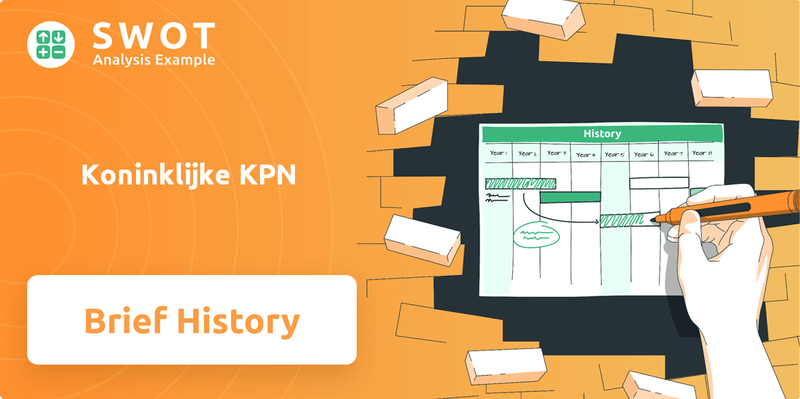
This brief history of KPN Netherlands reveals its transformation from a state-owned service to a dynamic, publicly traded company. Examining the KPN timeline, we'll explore its early days, major milestones, and the technological advancements that have defined its trajectory. Understanding KPN's history is crucial for grasping its role in Dutch telecommunications and its impact on the economy, offering valuable insights for investors and strategists alike.
What is the Koninklijke KPN Founding Story?
The story of Koninklijke KPN, a major player in the Dutch telecom industry, begins in 1752 with the establishment of the Statenpost, a postal service. However, the company's roots in telecommunications truly started in 1881 with the first telephone call in the Netherlands. This marked the beginning of what would evolve into one of the most significant telecommunications providers in the country.
The direct predecessor to KPN was the Staatsbedrijf der Posterijen, Telegrafie en Telefonie (PTT), formed in 1893. This entity merged postal, telegraph, and telephone services under one umbrella. It was later transformed into a state company in 1915 and officially became the State Company of Posts, Telegraphs and Telephony (PTT) in 1928. This consolidation set the stage for KPN's future growth and development within the Dutch telecommunications landscape.
The transformation of PTT into KPN began on January 1, 1989, when it gained independence and was renamed Koninklijke PTT Nederland N.V., or KPN. This shift allowed KPN to operate more independently. The initial focus was on restructuring to compete in a changing market, aiming to provide more options and potentially lower rates for consumers. This was a crucial step in the Competitors Landscape of Koninklijke KPN.
KPN's early business model centered on providing essential communication infrastructure and services, including fixed-line telephony. The introduction of the first public telephone kiosk in Amsterdam in 1931, a coin-operated device, was a significant milestone.
- KPN's initial funding came from its status as a state-owned enterprise.
- The government began privatizing KPN in 1994, listing it on the Amsterdam Stock Exchange.
- The privatization process was completed in 2006 with the relinquishing of the government's golden share veto rights.
- This transition marked a shift from state control to a more market-driven approach.
Koninklijke KPN SWOT Analysis
- Complete SWOT Breakdown
- Fully Customizable
- Editable in Excel & Word
- Professional Formatting
- Investor-Ready Format
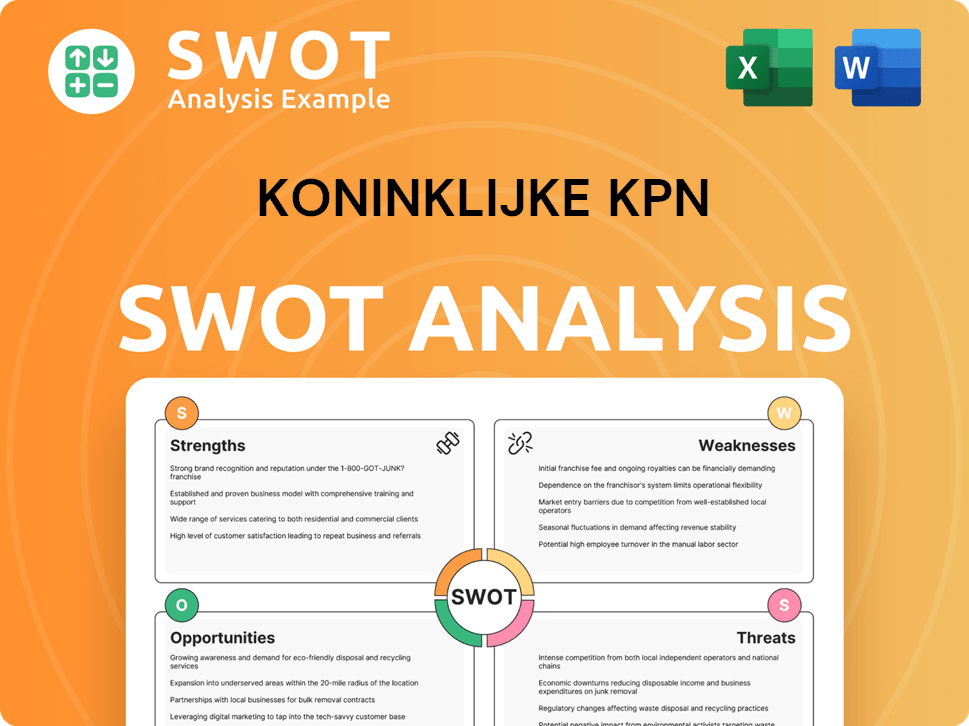
What Drove the Early Growth of Koninklijke KPN?
The early growth and expansion of Koninklijke KPN, a significant player in the Dutch telecom sector, marked a pivotal transition from a state-owned entity to a competitive telecommunications provider. This period saw the company strategically reposition itself through corporatization and unbundling. These changes allowed KPN to focus on commercial operations and expand its service offerings, laying the groundwork for its future in the telecommunications industry.
In 1989, KPN was corporatized as Koninklijke PTT Nederland NV, setting the stage for commercial operations. The separation of PTT Post and PTT Telecom in 1998, with PTT Telecom becoming KPN NV, was a key strategic move. This unbundling allowed KPN to concentrate on its core telecommunications activities, streamlining its focus and operational efficiency.
Around 2000, KPN spearheaded the rollout of ADSL internet across the Netherlands, in collaboration with internet providers. This significantly enhanced internet speeds, offering up to 2 Mbps. In 2004, KPN entered the digital television market by acquiring a stake in Digitenne and launching its IPTV service, MINE (later KPN iTV). By early 2010, KPN had surpassed one million digital TV subscribers, showcasing its early success in this sector.
KPN expanded internationally, notably owning E-Plus in Germany until its sale to Telefónica Germany in 2014, and Base in Belgium, which was sold to Telenet in 2015. In 2007, KPN acquired Getronics N.V., a global ICT services company, which broadened its IT services portfolio. These moves reflected KPN's strategy to diversify its operations and increase its market presence.
Ad Scheepbouwer was appointed CEO in 2001, leading a major reorganization to reduce debt and rebuild trust. This period saw KPN strategically shift its focus towards broadband internet, digital television, and international mobile operations. These strategic shifts were crucial in shaping KPN's trajectory as a diversified telecommunications and IT service provider.
Koninklijke KPN PESTLE Analysis
- Covers All 6 PESTLE Categories
- No Research Needed – Save Hours of Work
- Built by Experts, Trusted by Consultants
- Instant Download, Ready to Use
- 100% Editable, Fully Customizable
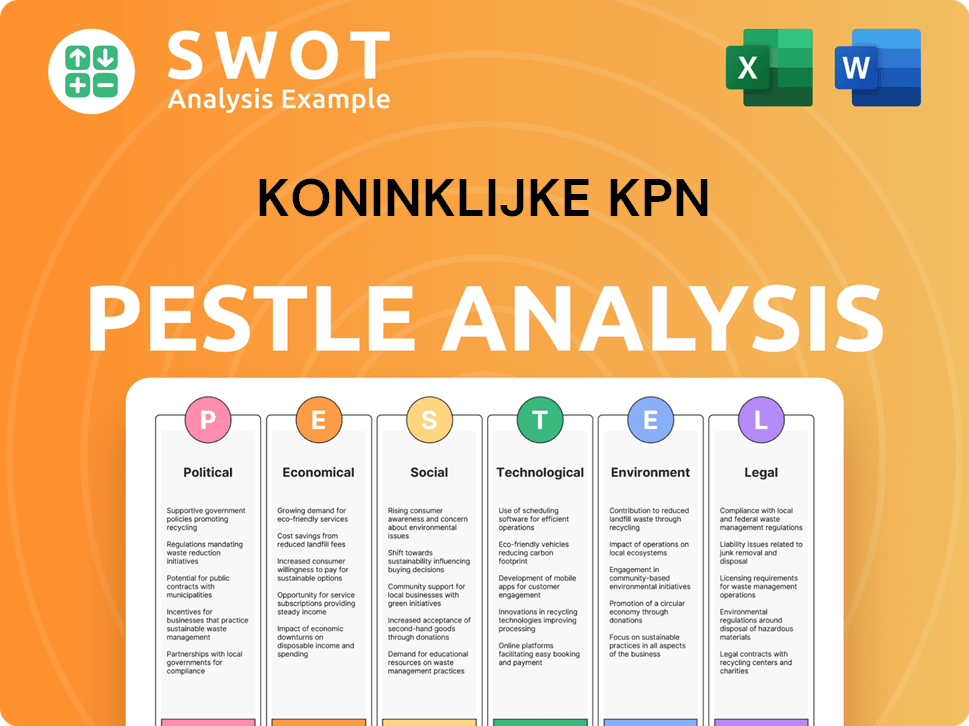
What are the key Milestones in Koninklijke KPN history?
The KPN history is marked by significant achievements, reflecting its evolution within the Dutch telecom sector. From its early days to its current status, Koninklijke KPN has consistently adapted to the changing telecommunications landscape, playing a crucial role in the Netherlands.
| Year | Milestone |
|---|---|
| Around 2000 | KPN introduced broadband internet to the Netherlands through ADSL, significantly increasing data transmission speeds. |
| 2015 | KPN achieved nationwide 4G coverage, becoming the first Dutch provider to do so. |
| 2019 | KPN consolidated all services under the KPN brand, integrating brands like XS4ALL and Telfort. |
| 2024 | KPN, together with Glaspoort, covered 63% of Dutch households with fiber. |
| 2024 | KPN acquired Youfone, expanding its customer base and market share. |
| 2024 | KPN announced a partnership with pension fund ABP to establish Althio, a new company for mobile transmission masts. |
Koninklijke KPN has consistently embraced innovation to stay ahead in the telecommunications Netherlands market. KPN has been at the forefront of network development, including the deployment of 5G, which is now available throughout the Netherlands and recognized for its quality.
KPN was a pioneer in bringing broadband internet to the Netherlands using ADSL technology around 2000, significantly improving data transmission rates for consumers and businesses.
In 2015, KPN achieved a milestone by becoming the first Dutch provider to offer nationwide 4G coverage, enhancing mobile internet access across the country.
KPN has made significant strides in deploying 5G throughout the Netherlands, ensuring advanced connectivity and faster speeds for its customers.
KPN is actively expanding its fiber optic network, with a goal to cover approximately 80% of Dutch households by the end of 2026, supporting the digitalization of the Netherlands.
KPN has formed strategic partnerships, such as the 2024 collaboration with ABP to create Althio, to strengthen its network infrastructure and service offerings.
Since 2015, KPN has invested in innovation through KPN Ventures and KPN Technology Labs, fostering technological advancements and maintaining its leadership in a rapidly evolving industry.
The KPN company has faced several challenges, including the transition from a state-owned entity to a fully privatized commercial enterprise. Market competition and the need to adapt to new technologies have also been constant hurdles for KPN's evolution over time.
The shift from a state-owned entity to a privatized company required significant restructuring and adaptation to a commercial market, impacting the company's operational strategies.
Intense competition within the telecommunications sector has consistently challenged KPN, requiring the company to innovate and adapt to maintain its market position.
KPN has had to navigate rapid technological advancements, including the adoption of new products and services, to remain competitive in the dynamic telecom market.
Consolidating various brands, such as Telfort and XS4ALL, under the KPN umbrella presented operational challenges, requiring careful integration strategies.
Integrating acquired companies, like Youfone in 2024, into KPN's existing infrastructure and service offerings demanded strategic planning and execution.
Economic downturns and market fluctuations have placed financial pressures on KPN, necessitating strategic financial management and adjustments.
For further insights into KPN's role in Dutch telecommunications, you can explore Revenue Streams & Business Model of Koninklijke KPN.
Koninklijke KPN Business Model Canvas
- Complete 9-Block Business Model Canvas
- Effortlessly Communicate Your Business Strategy
- Investor-Ready BMC Format
- 100% Editable and Customizable
- Clear and Structured Layout
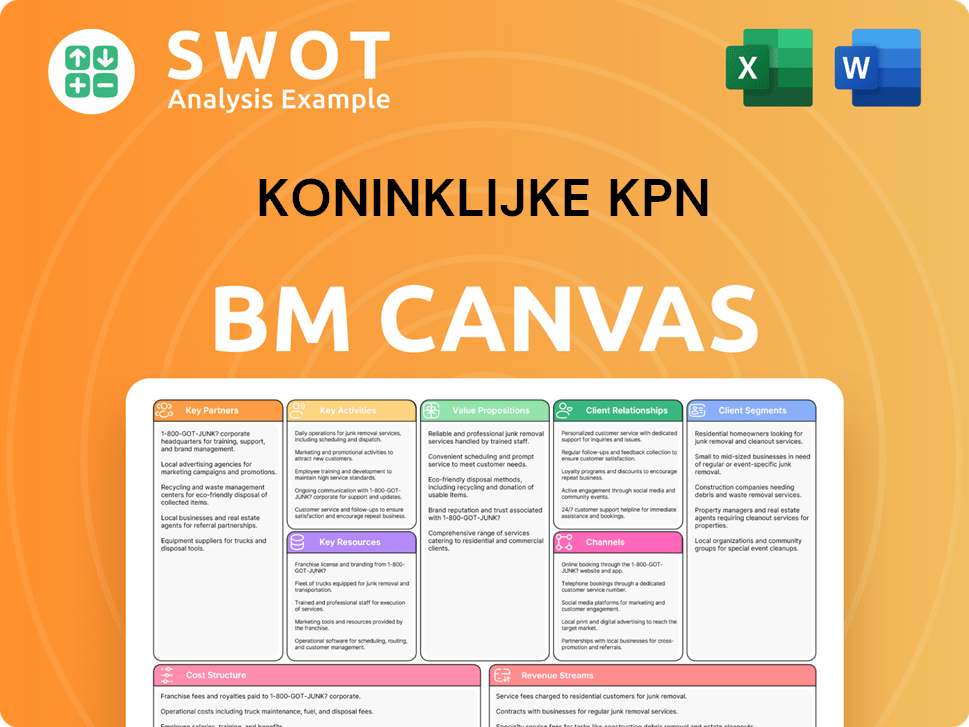
What is the Timeline of Key Events for Koninklijke KPN?
The KPN history is a story of innovation and adaptation within the Dutch telecom sector. From its earliest roots to its current status, Koninklijke KPN has consistently evolved. This evolution reflects broader trends in telecommunications Netherlands, navigating technological advancements and market shifts to maintain its position. The KPN company has been a key player in shaping how the Netherlands communicates.
| Year | Key Event |
|---|---|
| 1881 | The first telephone call in the Netherlands marked the beginning of KPN's telecommunications journey. |
| 1893 | The formation of Staatsbedrijf der Posterijen, Telegrafie en Telefonie (PTT) consolidated postal, telegraph, and telephone services. |
| 1989 | PTT was corporatized and renamed Koninklijke PTT Nederland NV (KPN), starting its transition towards independence. |
| 1994 | KPN began its privatization process, with shares listed on the Amsterdam Stock Exchange. |
| 1998 | PTT Post and PTT Telecom separated, with PTT Telecom becoming KPN NV. |
Koninklijke KPN is actively expanding its 5G network and fiber-optic infrastructure. This expansion aims to improve network capacity and provide faster and more reliable internet services across the Netherlands. Investment in these technologies is crucial for meeting the growing demands of consumers and businesses for high-speed connectivity. KPN's commitment to these technologies reflects its strategic focus on future-proofing its network infrastructure.
The company is investing in digital transformation initiatives to enhance customer experience and operational efficiency. This includes the development of new digital services and platforms. Furthermore, KPN is exploring innovations in areas such as IoT (Internet of Things) and smart solutions to diversify its offerings. These advancements aim to maintain competitiveness and create new revenue streams.
KPN continues to pursue strategic partnerships and acquisitions to strengthen its market position. These collaborations help KPN access new technologies and expand its service portfolio. Acquisitions of companies with complementary technologies can accelerate growth and market penetration. These moves are part of KPN's strategy to adapt to the changing dynamics of the telecommunications industry.
Sustainability is a key focus for Koninklijke KPN, with initiatives aimed at reducing its environmental footprint. This includes energy-efficient operations, waste reduction, and the promotion of sustainable practices throughout its supply chain. The company also emphasizes corporate social responsibility through various community engagement programs. These efforts align with broader trends in corporate governance and stakeholder expectations.
Koninklijke KPN Porter's Five Forces Analysis
- Covers All 5 Competitive Forces in Detail
- Structured for Consultants, Students, and Founders
- 100% Editable in Microsoft Word & Excel
- Instant Digital Download – Use Immediately
- Compatible with Mac & PC – Fully Unlocked
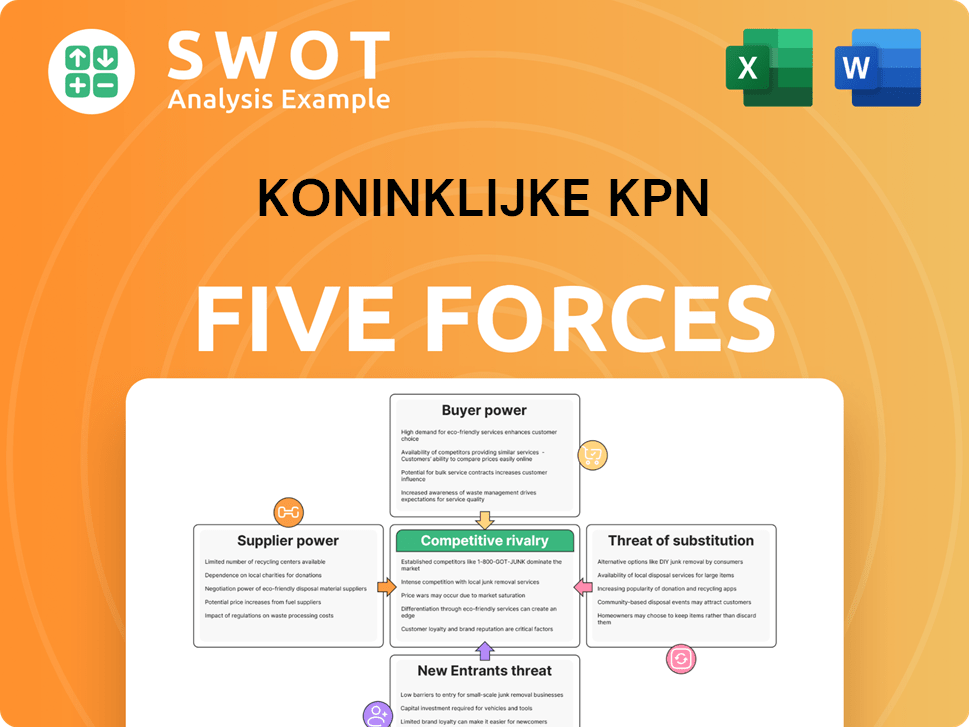
Related Blogs
- What is Competitive Landscape of Koninklijke KPN Company?
- What is Growth Strategy and Future Prospects of Koninklijke KPN Company?
- How Does Koninklijke KPN Company Work?
- What is Sales and Marketing Strategy of Koninklijke KPN Company?
- What is Brief History of Koninklijke KPN Company?
- Who Owns Koninklijke KPN Company?
- What is Customer Demographics and Target Market of Koninklijke KPN Company?
Disclaimer
All information, articles, and product details provided on this website are for general informational and educational purposes only. We do not claim any ownership over, nor do we intend to infringe upon, any trademarks, copyrights, logos, brand names, or other intellectual property mentioned or depicted on this site. Such intellectual property remains the property of its respective owners, and any references here are made solely for identification or informational purposes, without implying any affiliation, endorsement, or partnership.
We make no representations or warranties, express or implied, regarding the accuracy, completeness, or suitability of any content or products presented. Nothing on this website should be construed as legal, tax, investment, financial, medical, or other professional advice. In addition, no part of this site—including articles or product references—constitutes a solicitation, recommendation, endorsement, advertisement, or offer to buy or sell any securities, franchises, or other financial instruments, particularly in jurisdictions where such activity would be unlawful.
All content is of a general nature and may not address the specific circumstances of any individual or entity. It is not a substitute for professional advice or services. Any actions you take based on the information provided here are strictly at your own risk. You accept full responsibility for any decisions or outcomes arising from your use of this website and agree to release us from any liability in connection with your use of, or reliance upon, the content or products found herein.